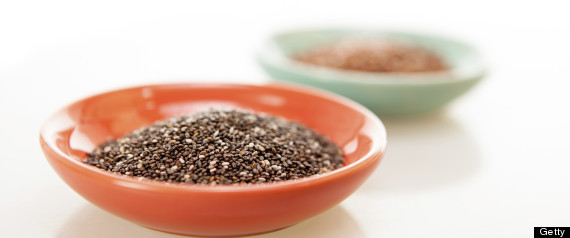Making dinner tonight?
Most home cooks know what staples to have on hand to give their food that extra oomph, but what if you're just as concerned about your health as you are about your culinary reputation? We put together our favorite pantry standbys -- foods that not only nourish, they elevate your dishes. Read on and tell us in the comments: What do you keep on hand to up the healthfulness of your food?
Cannellini Beans
Thanks to high protein, soluble fiber, iron and protein, beans are one of the most nutritious foods on the planet. And cannellini beans, in particular, are a superstar culinary ingredient thanks to their extremely mild taste and versatile form. Some people like to hide them in baked goods and pasta dishes, but they can be delicious when spotlighted, as in this dip from Food Network's Ellie Krieger[1] .
Chia Seeds
These grass seeds are full of nutrients like dietary fiber, omega-3 fatty acids, calcium, phosphorus and magnesium.[2] And thanks to their fibrous husks, they can actually create a jelly-like consistency. Try them as a thickening agent to up the nutrition profiles of jams[3] , puddings[4] and smoothies[5] .
Kippers
Have some grains and veggies, but craving a protein and omega-3 fatty acid boost? Tuna's a good option, but can be high in mercury, which all people (though especially children and women of child bearing age) need to monitor. Anchovies and sardines, by contrast, have all the benefits of other fatty fish, but are lower on the food chain and less likely to contain a heavy build-up of industrial pollution. On the other hand, they can have a strong, fishy taste. Kippers combine the best of both worlds: they're mild tasting and also lower in mercury.
Extra-Virgin Olive Oil
We all know that olive oil is good for us, thanks to monounsaturated fats that help regulate insulin levels and even lower cholesterol. But olive oil also has a protective effect against cancer and inflammation because of its richness in polyphenols.
It's important to make sure the olive oil you buy lives up to its label. According to journalist Tom Mueller, author of Extra Virginity: The Sublime and Scandalous World of Olive Oil, many olive oils are fraudulently cut with cheaper oils. How to tell the difference? Employ a simple taste test.
"You know what cheap olive oil tastes like? Oil. You know what good olive oil tastes like? Olives, flowers, sunshine," wrote Rebecca Orchant recently on HuffPost Taste[6] .
Coffee
Coffee has been linked to improving cardiovascular health, reducing cancer risk[7] and even fighting off Alzheimer's disease (OK, in mice). And keeping coffee beans on hand can have a culinary benefit beyond making a morning cup. Ground coffee provides a nice boost to baked goods[8] , sauces and even burgers.
Teff
Quinoa is wonderful, but Teff is quicker. The small seed -- from a species of grass called Lovegrass! -- has more calcium than any other whole grain (or seed)[9] . In fact, it has about the same amount of calcium as half a cup of cooked spinach, according to the Whole Grains Council.
Stir it into soups to thicken and up the fiber profile, grind it into a flour that can be used as a gluten-free substitute for baked goods or serve it in place of rice, quinoa or any other grain. If you're feeling ambitious, you could try to make an Ethiopian flatbread[10] called Injera.
Almonds
Truthfully, any nut is a good bead, though almonds have the distinction of lasting the longest on a shelf without going rancid. They have more calcium and fiber than other nuts[11] , according to Health.com and their sweet, distinctive taste pairs nicely with both savory and sweet dishes.
Kelp
As Greatist recently reported, seaweed may be the healthiest food you aren't eating[12] . Kelp, a type of brown seaweed, is particularly popular among health food enthusiasts for its briny taste and high levels of calcium, vitamins A and C and iodine.
Also on HuffPost:
References
- ^ dip from Food Network's Ellie Krieger (www.health.com)
- ^ dietary fiber, omega-3 fatty acids, calcium, phosphorus and magnesium. (www.huffingtonpost.ca)
- ^ jams (ohsheglows.com)
- ^ puddings (www.choosingraw.com)
- ^ smoothies (well.blogs.nytimes.com)
- ^ recently on HuffPost Taste (www.huffingtonpost.com)
- ^ reducing cancer risk (www.huffingtonpost.com)
- ^ boost to baked goods (www.epicurious.com)
- ^ any other whole grain (or seed) (wholegrainscouncil.org)
- ^ Ethiopian flatbread (chefinyou.com)
- ^ more calcium and fiber than other nuts (www.health.com)
- ^ the healthiest food you aren't eating (www.huffingtonpost.com)
- ^ Send us a tip (www.huffingtonpost.com)
- ^ Send us a photo or video (www.huffingtonpost.com)
- ^ Suggest a correction (www.huffingtonpost.com)

0 comments:
Post a Comment